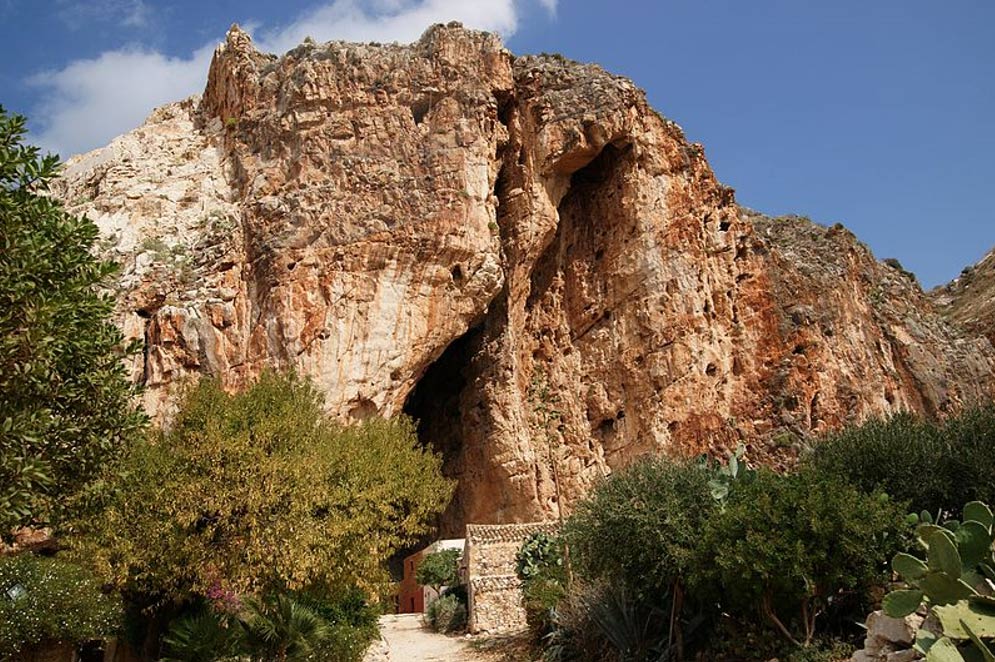
Mangiapane Cave (known also in Italian as Grotta Mangiapane) is a cave that has been occupied on and off since prehistoric times. In addition to being a prehistoric site, Mangiapane Cave is also well-known for being the location of a village that is reported to have been left untouched for the last 70 years. It is perhaps this aspect of the small village in Mangiapane Cave (i.e. being trapped in a time capsule) that draws people to visit this otherwise obscure site in Italy.
A Prehistoric Cave
Mangiapane Cave is located in the western part of the Italian island of Sicily. This cave is situated in the commune of Custonaci in the province of Trapani. In Custonaci there are a group of nine caves known as the Scurati Caves, where evidence of Sicily’s prehistoric inhabitants has been discovered.
Mangiapane Cave is the largest in this group of caves. The opening of the cave is measured to be around 80 m (242 ft.) in height, whilst the time-locked village is found to extend about 70 m (229 ft.) into the cave.

Grotta Mangiapane. (Flick/CC BY-NC 2.0)
Mangiapane Cave may have been settled as early as 20,000 years ago (corresponding to the Upper Paleolithic / Late Stone Age) or around 10,000 years ago (corresponding to the beginning of the Mesolithic). This conjecture is based on the cave paintings and stone tools (both of flint and obsidian) that have been found in the cave. Unfortunately, the archaeological finds from the prehistoric period of Mangiapane Cave seems to have not been well documented, and very little is known about the cave and its human inhabitants during this time.
The Modern Mangiapane Cave
Unlike the other parts of Sicily, Mangiapane Cave does not seem to have been an important settlement in the historical periods that followed the island’s prehistory. In fact, it seems that Mangiapane Cave was not even occupied following the prehistoric period. It was only relatively recently, i.e. during the early 1800s that Mangiapane Cave was once again settled by people.

House outside the cave. (CC BY 3.0)
It was the Mangiapane family who settled in this cave in more modern times, thus lending their name to this geographical feature. (As an aside, the word ‘mangiapane’ may be translated from Italian to English as ‘eat bread’.) A village was built by the Mangiapane family in this cave, and they lived in there for about 150 years, or until the middle of the 20th century. After this time, the village seems to have been abandoned yet again.
Whilst people ceased to inhabit the village in Mangiapane Cave, the settlement was neither entirely forgotten, nor left to the decaying effects of time. Fortunately for the site, a group of passionate local volunteers consulted with the surviving members of the Mangiapane family, and managed to preserve this site as it was. At the mouth of the cave, the piazza (public square) of the village can be found and further inside are the village houses, just as they were when left in the 1950s.

Inside the cave. (CC BY 3.0)
The cave still serves as a small rural farm (as evidenced by a number of geese in a coop) that produces food today. In addition to that, several feasts are still held by locals at the cave each year. One of these is a tradition known as the presepe vivente (which translates as the ‘live nativity scene’).
This event is performed in the cave around Christmas time, during which the old houses are also used by locals to demonstrate their trades and crafts. Finally, Mangiapane Cave has been featured in a couple of scenes in the 1999 TV film adaptation of Andrea Camilleri’s Il ladri di merendine (‘The Snack Thief’), the third novel (written in 1996) of the popular Il commissario Montalbano (‘Inspector Montalbano’) series.

The celebration of presepe vivente (Public Domain)
Featured image: The entrance of Mangiapane Cave. Photo source: (CC BY-SA 3.0)




